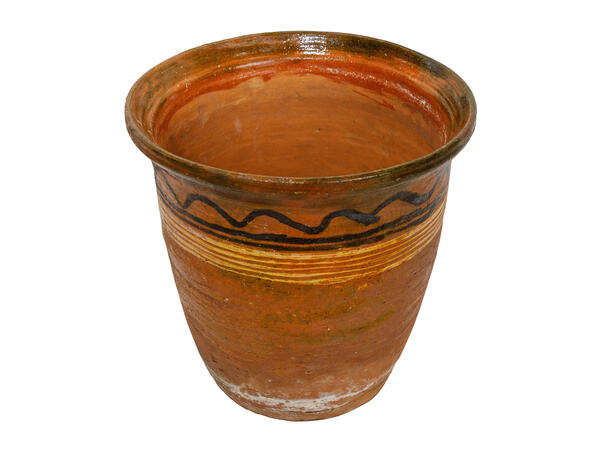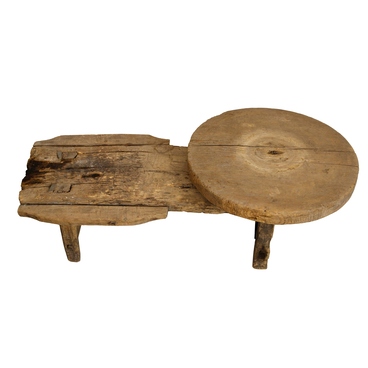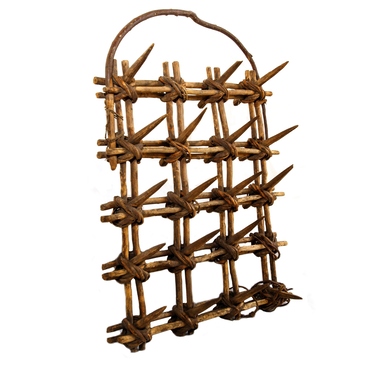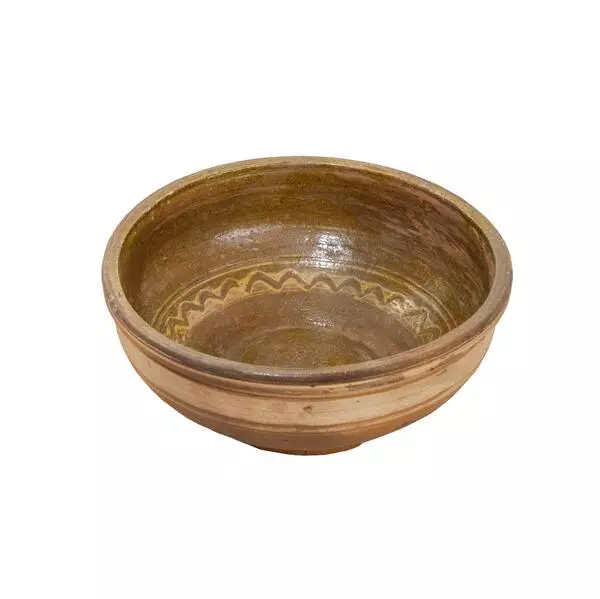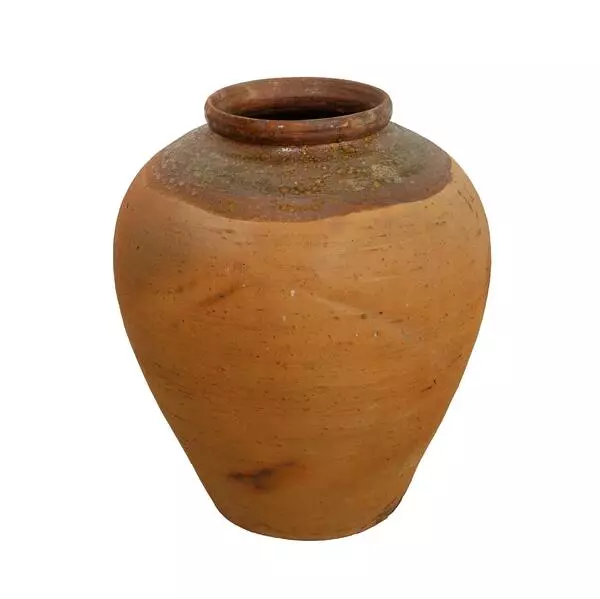A flowerpot for indoor flowers was given to the museum in 1976 by Kuzma Shitikhin, a potter from the village of Shishkeevo, Ruzaevsky district, Mordovian ASSR.
The clay container of reddish-ochre color is made in the form of a truncated cone, the outside is covered with greenish coating. This is the name of the liquid composition for the coating of pottery wares. In the center of the bottom there is a hole drilled for water drainage. The flowerpot is decorated with horizontal lines: A dark green zigzag stripe, underlined by two lines of the same color, and five light yellow stripes below.
The first information about the village of Shishkeevo dates back to 1638. Until 1928 it was part of the Insarsky uyezd, Penza province. Thanks to deposits of good quality clay, Shishkeevo became one of the pottery centers of the region: in Insarsky uyezd, almost a third of the handicrafters were engaged in pottery. Ceramics sold well at fairs, as it was used daily in peasant households.
Tableware and utensils for storing food were sold best. Metal utensils were expensive, glass was not yet popular, so earthenware was in great demand. The Shishkeev potters sold their wares themselves at the nearest fairs — in Saransk, Lada and Romodanovo. Over long distances, for example, to Spassk, Mokshan and Pochinki, fragile goods were usually carried by resellers who bought items from the masters wholesale.
Small dishes were especially popular with customers: pots, cups, milk jugs and flower pots. Shishkeevo potters produced inexpensive, unassuming items for all tastes and wallets. Adult craftsmen were engaged in making large pots, and 12-13 year old boys made trays for them. The craft of pottery was a family business: as a rule, hired workers and apprentices were not taken on. Children began to help the adults from the age of 8-10 years. At first, they carried pots, kneaded clay, then began to make simple items on the wheel, and by the age of 15-16 were quite independent potters.
Craftsmen did not build separate rooms for work. They thawed, kneaded, prepared clay, worked on potter’s wheel, dried and fired pottery in the house. They worked mainly in the winter time, from five in the morning till nine in the evening, making one or two dozen medium-sized pots during this time.
The clay container of reddish-ochre color is made in the form of a truncated cone, the outside is covered with greenish coating. This is the name of the liquid composition for the coating of pottery wares. In the center of the bottom there is a hole drilled for water drainage. The flowerpot is decorated with horizontal lines: A dark green zigzag stripe, underlined by two lines of the same color, and five light yellow stripes below.
The first information about the village of Shishkeevo dates back to 1638. Until 1928 it was part of the Insarsky uyezd, Penza province. Thanks to deposits of good quality clay, Shishkeevo became one of the pottery centers of the region: in Insarsky uyezd, almost a third of the handicrafters were engaged in pottery. Ceramics sold well at fairs, as it was used daily in peasant households.
Tableware and utensils for storing food were sold best. Metal utensils were expensive, glass was not yet popular, so earthenware was in great demand. The Shishkeev potters sold their wares themselves at the nearest fairs — in Saransk, Lada and Romodanovo. Over long distances, for example, to Spassk, Mokshan and Pochinki, fragile goods were usually carried by resellers who bought items from the masters wholesale.
Small dishes were especially popular with customers: pots, cups, milk jugs and flower pots. Shishkeevo potters produced inexpensive, unassuming items for all tastes and wallets. Adult craftsmen were engaged in making large pots, and 12-13 year old boys made trays for them. The craft of pottery was a family business: as a rule, hired workers and apprentices were not taken on. Children began to help the adults from the age of 8-10 years. At first, they carried pots, kneaded clay, then began to make simple items on the wheel, and by the age of 15-16 were quite independent potters.
Craftsmen did not build separate rooms for work. They thawed, kneaded, prepared clay, worked on potter’s wheel, dried and fired pottery in the house. They worked mainly in the winter time, from five in the morning till nine in the evening, making one or two dozen medium-sized pots during this time.

